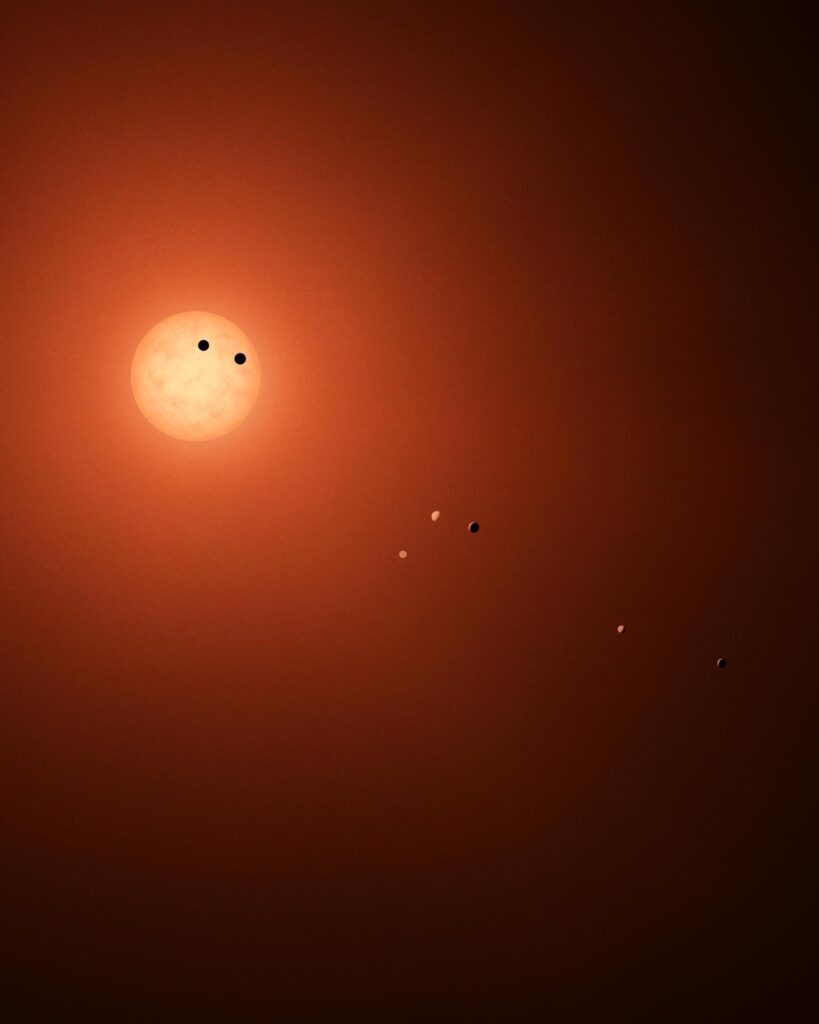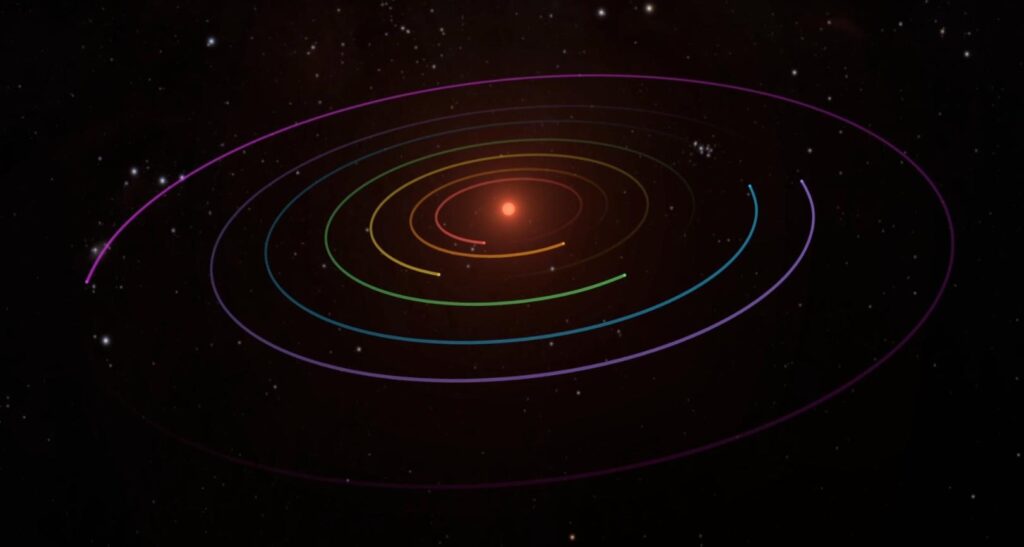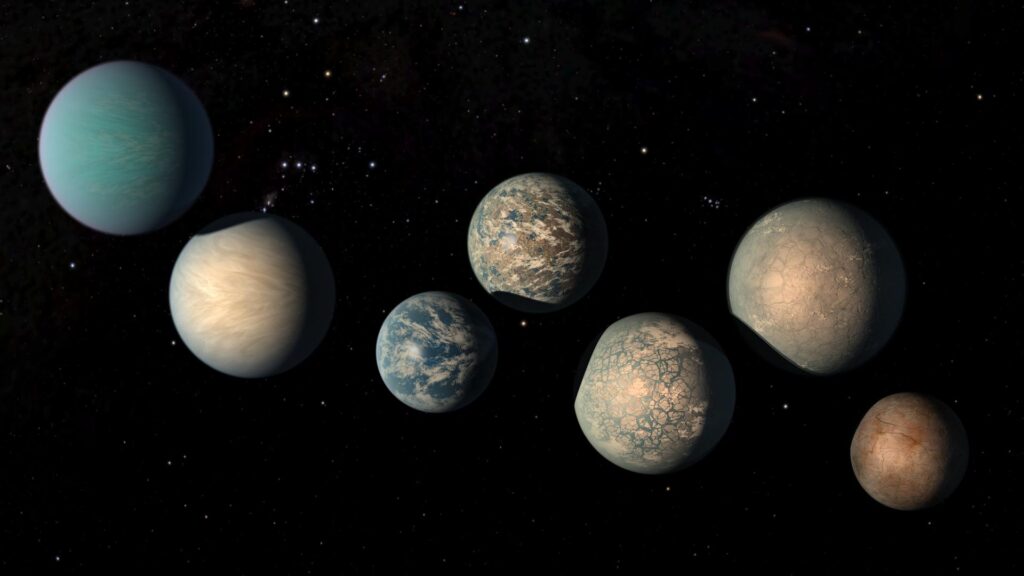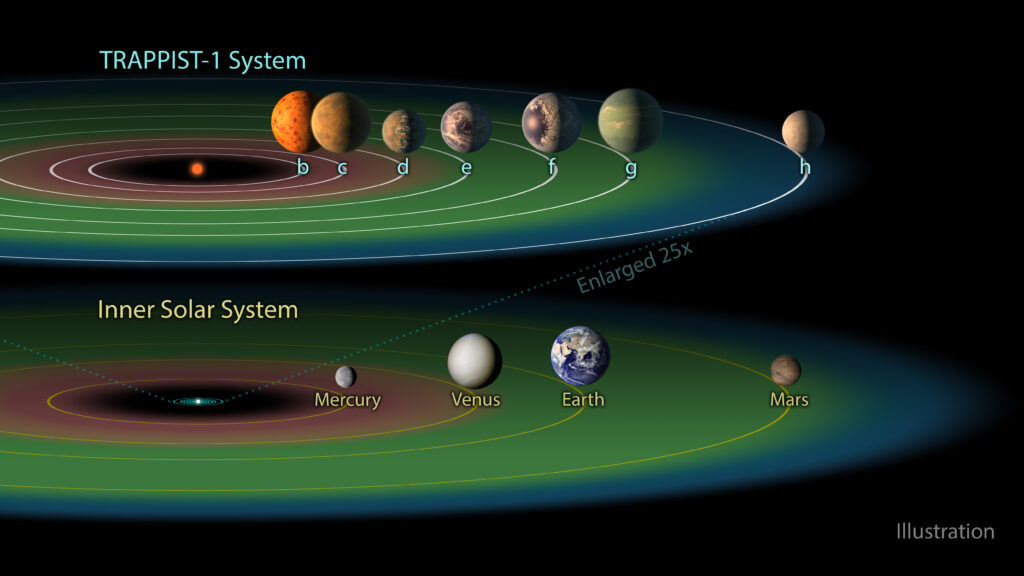Secrets of a Remarkable Star System
© NASA/JPL-Caltech
TRAPPIST-1 is a remarkable red dwarf star located approximately 40.66 light-years from Earth in the Aquarius constellation. This cool, low-mass star has a surface temperature of around 2,566 K (2,290 °C; 4,160 °F) and a radius slightly larger than that of Jupiter. With a mass of only about 9% of the Sun, this star is a diminutive celestial body compared to our star. The TRAPPIST-1 system was first discovered and reported in the scientific literature in 2000. Based on current estimates, this planetary system is believed to be approximately 7.6 billion years old, making it older than our own Solar System.
Orbiting this unassuming red dwarf are seven known exoplanets, designated TRAPPIST-1b through 1h. These planets are all similar in size to Earth, making them terrestrial. Remarkably, three of these planets – TRAPPIST-1e, 1f, and 1g – are situated within the star’s habitable zone, where conditions could potentially support the existence of liquid water on their surfaces.
In 2016, observations conducted by the Transiting Planets and Planetesimals Small Telescope (TRAPPIST) at La Silla Observatory in Chile, along with other telescopes, unveiled the presence of two terrestrial planets orbiting the red dwarf star. Subsequent analysis in 2017 of these initial observations revealed an additional five terrestrial planets within the system.
Following circular paths, the seven terrestrial planets in the TRAPPIST-1 system complete their orbits around the star in remarkably short periods, ranging from about 1.5 to 19 days. These planets are believed to be tidally locked to the dwarf star, resulting in a permanent day on one side of each planet facing the star, while the other side experiences perpetual night. With masses comparable to Earth, these planets are all aligned in a single plane, creating a striking visual as they appear to traverse across the star’s disk from the vantage point of Earth.
STAR

Located in the constellation Aquarius, approximately five degrees south of the celestial equator, TRAPPIST-1 stands out as a relatively close star, positioned at a distance of 40.66±0.04 light-years from Earth. This solitary star exhibits a significant proper motion and lacks any companion stars in its vicinity.
Characterized as a red dwarf of spectral class M8.0±0.5, TRAPPIST-1’s classification indicates its relatively small size and cool temperature. With a radius just 12% that of the Sun, this star is only marginally larger than Jupiter, albeit significantly more massive. Its mass, approximately 9% that of the Sun, is adequate for sustaining nuclear fusion processes within its core.
Noteworthy for its unusually low density among red dwarfs, TRAPPIST-1 boasts a low effective temperature of 2,566 K (2,293 °C), earning it the distinction, as of 2022, of being the coldest-known star known to host planets. The star’s frigid conditions allow for the formation of condensates in its photosphere, a phenomenon detected through the polarization induced in its radiation during planetary transits.
Despite lacking evidence of a stellar cycle, the star emits a mere 0.055% of the Sun’s luminosity, predominantly in the form of infrared radiation. Observations from the XMM-Newton satellite and other instruments reveal faint radiation at shorter wavelengths like x-rays and UV radiation, while no radio wave emissions have been detected from this intriguing celestial body.
ROTATION PERIOD AND AGE
The rotation period and age of the dwarf star have been extensively studied. The rotation period of TRAPPIST-1 is approximately 3.295 days, which is average for late-type M dwarfs, suggesting it is a “middle-aged” star, estimated to be between 3-8 billion years old. However, further analysis suggests a more precise age of 7.6 ± 2.2 billion years for TRAPPIST-1, indicating it is a transitional thin/thick disk star. This age estimation is crucial for understanding the formation, stability, and habitability of the planets in the TRAPPIST-1 system.
The age of the dwarf star is significant in assessing the potential habitability of its planets. Older stars like TRAPPIST-1 are less active, with fewer flares compared to younger stars. However, the planets near the star have been exposed to high-energy radiation for billions of years, potentially affecting their atmospheres and water content. Despite being older than our solar system, the star is considered stable and has likely evolved together with its planets over billions of years, indicating a system that has persisted for a long time.
PLANETARY SYSTEM

The star system is a remarkable planetary system located 39 light-years away from Earth, in the constellation of Aquarius. It consists of an ultra-cool dwarf star, TRAPPIST-1A, which is only slightly larger than Jupiter and 12 times less massive than the Sun. Orbiting this star are at least seven Earth-sized, temperate exoplanets, designated TRAPPIST-1b through TRAPPIST-1h.
The planets were discovered using the transit method, where they pass in front of their host star, causing a slight dip in the star’s brightness. This allowed astronomers to measure the orbital periods of the planets and calculate their sizes. The exact timing of the transits also provided a means to determine the masses of the planets, leading to knowledge of their densities and bulk properties.
The TRAPPIST-1 planets have sizes and masses comparable to Earth and Venus. They receive an amount of light similar to many planets in our Solar System, from Mercury to Mars. All seven planets could easily fit inside the orbit of Mercury, the innermost planet of our Solar System. The proportions of the star system look more like Jupiter and its moons.
Detailed studies of the TRAPPIST-1 planets’ masses and radii suggest that planets c and e are likely to have rocky interiors, while planets b, d, f, g, and h require envelopes of volatiles in the form of thick atmospheres, oceans, or ice, in most cases with water mass fractions ≲5%. The resonant structure of the system is a telltale sign of orbital migration, indicating that the entire system migrated in concert.
Three of the TRAPPIST-1 planets (e, f, and g) are firmly located in the habitable zone, the area around the parent star where a rocky planet is most likely to have liquid water on its surface. However, the actual habitability of these planets depends on factors such as their atmospheric composition and evolution, which are still being studied.
PLANETS

TRAPPIST-1b
TRAPPIST-1b is one of the seven Earth-sized exoplanets orbiting the TRAPPIST-1 star, located about 40 light-years from Earth. It is the second planet from its host star in the system.
TRAPPIST-1b is slightly larger than Earth, with a radius of about 1.1 Earth radii. It orbits its star every 1.5 days at a distance of about 0.02 AU, making it a Super-Earth exoplanet. The planet likely has a rocky composition, but its mass and radius suggest it could have a dense atmosphere or even an ocean. However, its proximity to its star means it likely experiences extreme tidal heating and is too hot to support liquid water on its surface.
TRAPPIST-1c
TRAPPIST-1c is a rocky exoplanet orbiting the ultra-cool dwarf star. Observations with the James Webb Space Telescope suggest that TRAPPIST-1c, similar in size and temperature to Venus, may have a tenuous atmosphere with minimal carbon dioxide or could be a barren rocky planet. The planet’s gravitational pull, 10% stronger than Earth’s, may aid in retaining its atmosphere. It is tidally locked, showing two distinct hemispheres – one in constant day and the other in eternal night, with a day and year lasting about 2.42 Earth days.
Further observations are needed to distinguish between a rocky planet and one with a thin atmosphere, with hopes that TRAPPIST-1c and similar planets could provide insights into the survivability of atmospheres around red dwarf stars.
TRAPPIST-1d
TRAPPIST-1d is a rocky exoplanet orbiting the dwarf star, located about 40 light-years from Earth. It is the fourth planet from its host star in the system.
TRAPPIST-1d is slightly smaller than Earth, with a radius about 25% smaller than Earth’s. It orbits its star every 4.05 days at a distance of about 0.02 AU, making it one of the innermost planets in the system. The planet likely has a rocky composition, but its mass and radius suggest it could have a dense atmosphere or even an ocean. However, its proximity to its star means it likely experiences extreme tidal heating and is too hot to support liquid water on its surface.
TRAPPIST-1e
TRAPPIST-1e is a rocky exoplanet orbiting the ultra-cool dwarf star TRAPPIST-1. It is the fifth planet from its host star in the system.
TRAPPIST-1e is very close in size to Earth, with a radius about 0.9 times that of Earth. It orbits its star every 6.1 days at a distance of about 0.03 AU, receiving about the same amount of light as Earth. The planet likely has a rocky composition, but its mass and radius suggest it could have a dense atmosphere or even an ocean. However, its proximity to its star means it likely experiences extreme tidal heating and is too hot to support liquid water on its surface.
TRAPPIST-1f
TRAPPIST-1f is a rocky exoplanet orbiting the star. It is the sixth planet from its host star in the system.
TRAPPIST-1f is slightly larger than Earth, with a radius about 1.04 times that of Earth. It orbits its star every 9.2 days at a distance of about 0.037 AU, receiving about half the amount of light as Earth. The planet likely has a rocky composition, but its mass and radius suggest it could have a dense atmosphere or even an ocean. However, its proximity to its star means it likely experiences extreme tidal heating and is too hot to support liquid water on its surface.
TRAPPIST-1g
TRAPPIST-1g is the seventh planet from its host star in the system.
TRAPPIST-1g is the largest planet in the system, with a radius about 13% larger than Earth’s. It orbits its star at a distance that places it within the habitable zone, where liquid water could potentially exist on its surface. Despite orbiting very close to its host star, TRAPPIST-1g receives a moderate amount of radiation, making it a promising candidate for habitability.
TRAPPIST-1h
TRAPPIST-1h is one of the seven Earth-sized exoplanets orbiting the dwarf star, located approximately 40 light-years away from Earth. It is the outermost planet in the system.
TRAPPIST-1h is one of the smallest planets in the system, with a radius about 25% smaller than Earth’s. It orbits its star at a distance that places it on the outer edge of the habitable zone, where conditions for liquid water could potentially exist on its surface. Despite its distance from the star, TRAPPIST-1h may still have regions conducive to supporting life.
POTENTIAL HABITABILITY

The TRAPPIST-1 planets are labeled in order of their distance from the star, with TRAPPIST-1e being one of the most promising candidates for habitability. This planet orbits within the star’s habitable zone, where liquid water could potentially exist on the surface. Due to frequent interactions, the planets in the star system are anticipated to experience significant tidal forces. Should these planets possess oceans, these tides may result in cyclical flooding and drying of coastal areas, initiating chemical reactions that could support the emergence of life. Additionally, these tidal forces could potentially influence the evolution of biological rhythms. However, the habitability of TRAPPIST-1e and other planets in the system depends on several factors, including the composition and evolution of their atmospheres.
Recent studies using the James Webb Space Telescope (JWST) have begun to characterize the atmospheres of TRAPPIST-1 planets, but determining whether they have atmospheres at all is still a challenge. The dwarf star may not produce sufficient quantities of radiation for photosynthesis to support an Earth-like biosphere.
Another factor that complicates the habitability assessment is the activity of the host star, TRAPPIST-1. Red dwarfs like TRAPPIST-1 are known to be prone to flares and other activities that can strip away planetary atmospheres and make conditions inhospitable for life. However, it’s possible that planets with sufficient atmospheres and cloud cover could still maintain stable climates and potentially support life.
In summary, while the TRAPPIST-1 system is an exciting target for the search for habitable exoplanets, more research is needed to determine the actual habitability of its planets. Ongoing and future observations with powerful telescopes like JWST will provide crucial insights into the atmospheric composition and evolution of these worlds, helping to narrow down the search for potentially habitable exoplanets.
